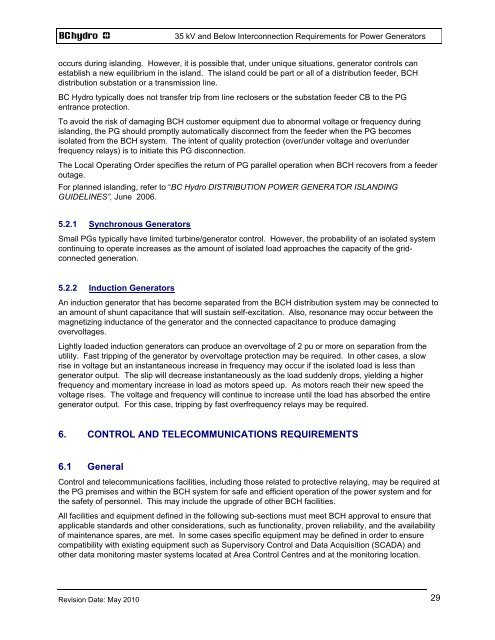35 kV and Below INTERCONNECTION REQUIREMENTS - BC Hydro
35 kV and Below INTERCONNECTION REQUIREMENTS - BC Hydro
35 kV and Below INTERCONNECTION REQUIREMENTS - BC Hydro
You also want an ePaper? Increase the reach of your titles
YUMPU automatically turns print PDFs into web optimized ePapers that Google loves.
Revision Date: May 2010<br />
<strong>35</strong> <strong>kV</strong> <strong>and</strong> <strong>Below</strong> Interconnection Requirements for Power Generators<br />
occurs during isl<strong>and</strong>ing. However, it is possible that, under unique situations, generator controls can<br />
establish a new equilibrium in the isl<strong>and</strong>. The isl<strong>and</strong> could be part or all of a distribution feeder, <strong>BC</strong>H<br />
distribution substation or a transmission line.<br />
<strong>BC</strong> <strong>Hydro</strong> typically does not transfer trip from line reclosers or the substation feeder CB to the PG<br />
entrance protection.<br />
To avoid the risk of damaging <strong>BC</strong>H customer equipment due to abnormal voltage or frequency during<br />
isl<strong>and</strong>ing, the PG should promptly automatically disconnect from the feeder when the PG becomes<br />
isolated from the <strong>BC</strong>H system. The intent of quality protection (over/under voltage <strong>and</strong> over/under<br />
frequency relays) is to initiate this PG disconnection.<br />
The Local Operating Order specifies the return of PG parallel operation when <strong>BC</strong>H recovers from a feeder<br />
outage.<br />
For planned isl<strong>and</strong>ing, refer to “<strong>BC</strong> <strong>Hydro</strong> DISTRIBUTION POWER GENERATOR ISLANDING<br />
GUIDELINES”, June 2006.<br />
5.2.1 Synchronous Generators<br />
Small PGs typically have limited turbine/generator control. However, the probability of an isolated system<br />
continuing to operate increases as the amount of isolated load approaches the capacity of the gridconnected<br />
generation.<br />
5.2.2 Induction Generators<br />
An induction generator that has become separated from the <strong>BC</strong>H distribution system may be connected to<br />
an amount of shunt capacitance that will sustain self-excitation. Also, resonance may occur between the<br />
magnetizing inductance of the generator <strong>and</strong> the connected capacitance to produce damaging<br />
overvoltages.<br />
Lightly loaded induction generators can produce an overvoltage of 2 pu or more on separation from the<br />
utility. Fast tripping of the generator by overvoltage protection may be required. In other cases, a slow<br />
rise in voltage but an instantaneous increase in frequency may occur if the isolated load is less than<br />
generator output. The slip will decrease instantaneously as the load suddenly drops, yielding a higher<br />
frequency <strong>and</strong> momentary increase in load as motors speed up. As motors reach their new speed the<br />
voltage rises. The voltage <strong>and</strong> frequency will continue to increase until the load has absorbed the entire<br />
generator output. For this case, tripping by fast overfrequency relays may be required.<br />
6. CONTROL AND TELECOMMUNICATIONS <strong>REQUIREMENTS</strong><br />
6.1 General<br />
Control <strong>and</strong> telecommunications facilities, including those related to protective relaying, may be required at<br />
the PG premises <strong>and</strong> within the <strong>BC</strong>H system for safe <strong>and</strong> efficient operation of the power system <strong>and</strong> for<br />
the safety of personnel. This may include the upgrade of other <strong>BC</strong>H facilities.<br />
All facilities <strong>and</strong> equipment defined in the following sub-sections must meet <strong>BC</strong>H approval to ensure that<br />
applicable st<strong>and</strong>ards <strong>and</strong> other considerations, such as functionality, proven reliability, <strong>and</strong> the availability<br />
of maintenance spares, are met. In some cases specific equipment may be defined in order to ensure<br />
compatibility with existing equipment such as Supervisory Control <strong>and</strong> Data Acquisition (SCADA) <strong>and</strong><br />
other data monitoring master systems located at Area Control Centres <strong>and</strong> at the monitoring location.<br />
29
















